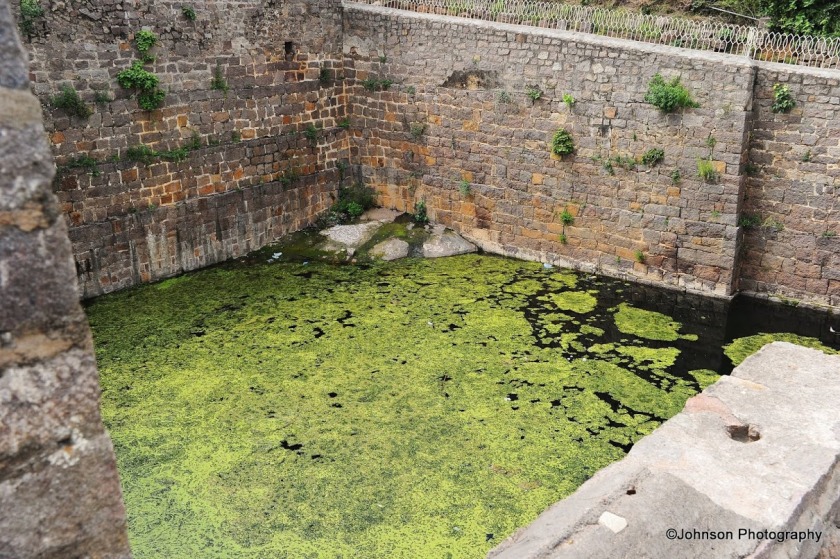The Golconda fort is undoubtedly one of the most magnificent fortress complexes in India. The fortress rests on a granite hill 120 meters high surrounded with huge crenellated ramparts. Golconda also known as Gol konda (Round shaped hill) or Golla Konda (Shepherd’s hill) is a citadel cum fort. It is located 11 km from the city of Hyderabad in the Indian state of Telangana. The region is famous for the mines that have produced some of the world’s most famous gems like Koh-i-noor and Hope Diamond. The fort used to have a vault where once these diamonds were stored.
Golconda Fort was first built by the Kakatiya dynasty as part of their western defenses. The fort was rebuilt and strengthened by Rani Rudrama Devi and her successor Prataparudra. Later the fort came under the control of the Musunuri Nayaks, who defeated the Tughlaqi army occupying Warangal. It was ceded by Musunuri Kapaya Nayak to the Bahmini Sultante as part of the treaty in 1364. Under Bahmini rule, Golconda slowly rose to prominence and Sultan Quli Qutub-ul-Mulk was sent to Golconda as the governor in 1501 AD. Bahmini rule gradually weakened during this period and Sultan Quli formally became independent in 1538 AD, establishing the Qutub Shahi dynasty based in Golconda. Over a period of 62 years, the mud fort was expanded by the first three Qutub Shahi sultans into the present structure, a massive fortification of granite extending around 5 km in circumference. It remained the capital of the Qutub Shahi dynasty until 1590 when the capital was shifted to Hyderabad, but the fort remained to be the stronghold of the dynasty.
In January 1687 AD, Mughal Emperor Aurangzeb led his force to besiege the Qutub Shahi dynasty at Golconda Fort. He surrounded the fort with 100 canons in order to breach the granite walls of the fort but with no success. The siege of Golconda lasted 8 months and on various occasions it had pushed the massive Mughal army to its limits, in fact the Golconda fort was probably the most impregnable fort in South Asia. After a siege of 8 months, the Mughals entered the fort through a decisive victory but through the secret treachery of Sarandaz Khan, a military official in the army of the Qutub Shahi dynasty, who was bribed to open one gate and let the Mughals enter the fort. Aurangzeb left the fort intentionally in ruins.
The Golconda consists of four distinct forts with a 10 km long outer wall with 87 semicircular bastions (some still mounted with cannons), eight gateways and four drawbridges, with a number of royal apartments and halls, temples, mosques, magazines, stables etc. The lowest of these is the outermost enclosure into which we enter by “Fateh Darwaza” or Victory Gate (so called after Aurangzeb’s triumphant army marched in through this gate), studded with giant iron spikes (to prevent elephants from battering them down) near the southern corner. At Gateh Darwaza one can experience the fantastic acoustic effect. A hand clap at certain point below the dome at the entrance reverberates and can be heard clearly at the main hall, almost a kilometer away, a warning note to the royals in case of attacks.
It is an arduous task to discover every nook and corner of the Golconda fort which spreads across an area of 11 kms. A visit to the fort reveals the architectural beauty of the various buildings in the complex.









































Some great pictures of golconda fort -one of its kind
LikeLike
Thank you very much for your visit and the comments.
LikeLiked by 1 person
🙂
LikeLike
Wonderful! It will surely take an entire day just to have a proper look around!
LikeLike
Thanks.
LikeLiked by 1 person
Wonderful and just so much history in your photo’s.Thanks also for all the information.
LikeLike
Thank you very much for your kind words.
LikeLike
Such lovely pictures!
LikeLike
Thanks.
LikeLike
I’m always amazed by castles, forts, etc. These were great photos.
LikeLike
Thank you very much for stopping by my blog and commenting.
LikeLiked by 1 person
You put so much work into your posts- thought, passion and heart. And I love travel pictures.
LikeLike
Yes, it is my passion… Nice to know that you liked it.
LikeLiked by 1 person
Incredible place!
LikeLiked by 1 person
It looks amazing 🙂
LikeLike
Thanks.
LikeLike
I love these pictures. So interesting to explore the world.
LikeLike
Thank you very much.
LikeLike
Enjoyable post.
LikeLike
Thanks.
LikeLiked by 1 person
I wish I could take pictures like you! Gorgeous pictures!
LikeLike
Thank you very much for stopping by my blog and the comments.
LikeLiked by 1 person
Wow what beautiful photos
LikeLike
Thanks.
LikeLike